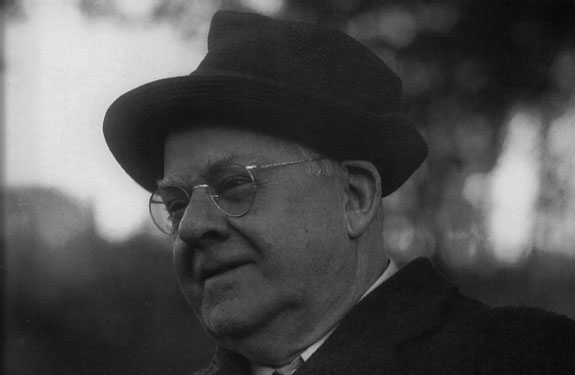March 8
Born on this day in 1865 in Bloomington, Illinois, Frederic W. Goudy lived to be the best known American printer of his times. He achieved international renown as a letterer, a type designer, and a typographer. He was also the operator of a most distinguished private press, the Village Press.
Fred Goudy came late to his great career. He was thirty-three years of age before he decided that the printer’s art was the one he most desired to follow. In 1899 he had already designed his first type, Camelot, for the Dickinson Type Foundry of Boston. He had also dabbled in lettering and advertising design, at the same time becoming more and more disillusioned with his vocation of book-keeper.
When he established himself in Chicago as a free-lance designer, he knew merely that he was drawn toward the practice of typography. From that time on, nothing occurred to make him change his mind. He obtained a post as instructor in lettering at the Frank Holme School of Illustration and provided inspiration to such future greats as Bill Dwiggins, Oz Cooper and Will Ransom. With Will Ransom in 1903 he set up the Village Press in Park Ridge, Illinois. For the next forty years it was to be a motivating factor in his life in such locations as Hingham, Massachusetts, New York City, and Marlborough-on-Hudson.
In 1897 he married Bertha Sprinks. She was to stand at his side in all of his endeavors, particularly the Village Press, until her death in 1935. Goudy’s career as a type designer began in earnest in 1910 when he designed a type for the setting of a book by H.G. Wells, The Door in the Wall, published by Mitchell Kennerley, for whom the type was named. Kennerley was followed by an inscriptional roman font called Forum. Both of these types were widely admired in the United States and in Europe.
In 1915 he designed for the American Type Founders Company a face which was called Goudy Old Style. It became an immediate commercial success. There was so much demand for this letter that the foundry issued such variants as a bold face and an extra-bold, in addition to an inline version called hand-tooled; in none of these, however, did Goudy have a hand. And of course he received no royalties, even though the series carried his name. Until 1944 scarcely a year was to pass without the introduction of a new Goudy type, many of which were produced by Lanston Monotype Company.
Goudy was completely individualistic as a type designer. He drew all of his letters freehand. From time to time Lanston found it necessary to change some of the characteristics of his letters to conform to the mechanics of matrix manufacture. In order to be completely free of such interference, Goudy set up his own Village Letter Foundery, in which he could control every step of manufacture. Thus, he suffered a complete disaster when in 1939 his workshop burned, destroying everything which he had created during the preceding fifteen years—drawings, matrices, type, and equipment. The types which he himself sold had had a relatively narrow distribution. Now they were gone forever. At the age of seventy-four he found it necessary to begin all over again. This he almost immediately proceeded to do.
Goudy was an inspired drawer of roman letters. His inspiration was the Italian 15th century letterform. He was constantly attempting to execute the most perfect roman type based on the classic examples. In his search, he was not at all commercial, as he refused to take the time to cut a variety of sizes in each type which he designed. As soon as a design was completed, his mind was visualizing improvements, and he was off on a new search for his ideal.
Throughout his long career he designed 123 types, most of which are in the category of “lost Goudy types.” He never designed a letter for the manufacturers of line-casting machines, although his Goudy O.S. has been adapted for that use. His book types were all cut for use with the Monotype machine. Fortunately a number of these are still available, such as Garamont, Deepdene, Italian Old Style, Kennerley, Goudy Modern, Californian, Village No. 2, etc.
Goudy was in the tradition of the great type designers of history. He spent a great deal of his time writing and lecturing about typography, providing further inspiration for knowledge and understanding of the craft of the printer. His death in 1947 at the age of eighty-two brought to an end his personal involvement, but many of his types will undoubtedly speak in his name for generations to come.
